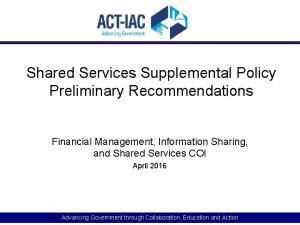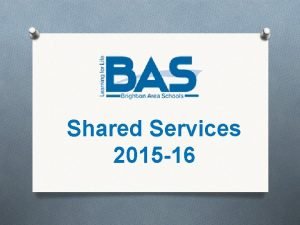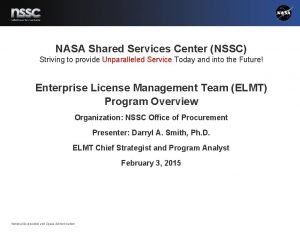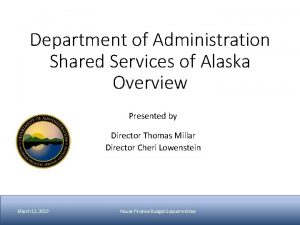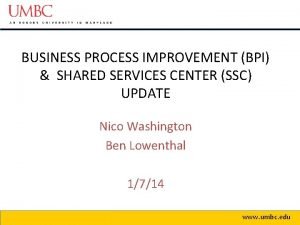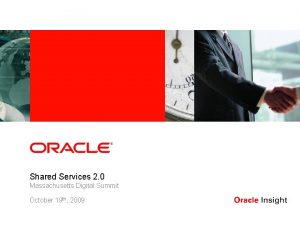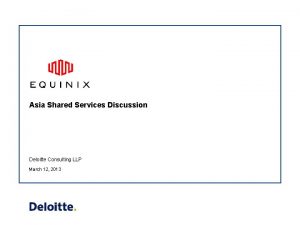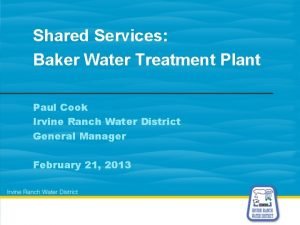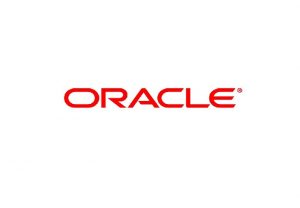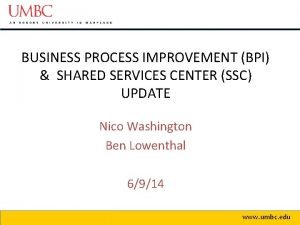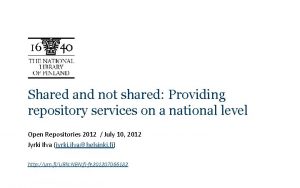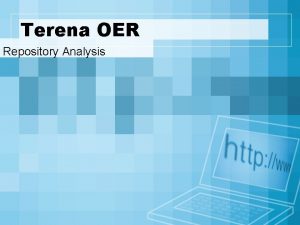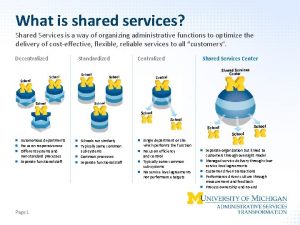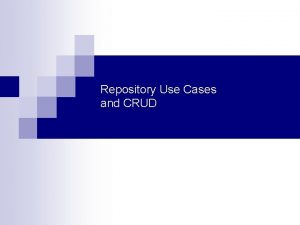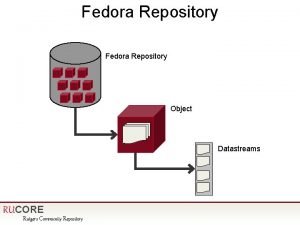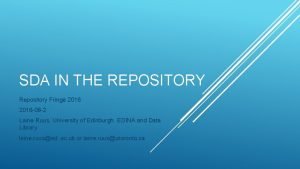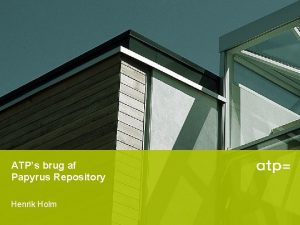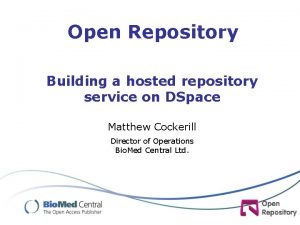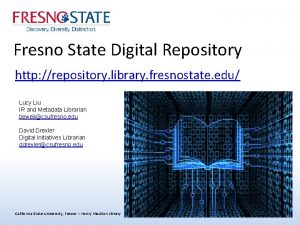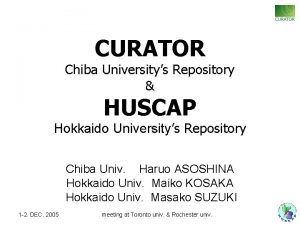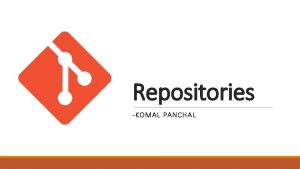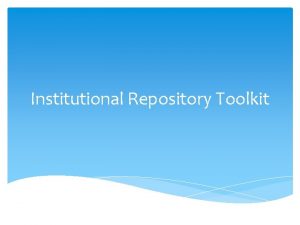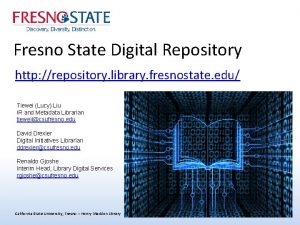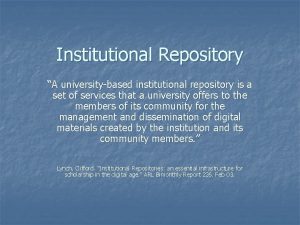Shared and not shared Providing repository services on



























- Slides: 27

Shared and not shared: Providing repository services on a national level Open Repositories 2012 / July 10, 2012 Jyrki Ilva (jyrki. ilva@helsinki. fi) http: //urn. fi/URN: NBN: fi-fe 201207066182

This presentation deals with shared services in a very concrete form, from the point of view of a national service provider from a small Northern European country… NATIONAL LIBRARY NETWORK SERVICES

FINLAND § A country of 5 million people § With a relatively uniform higher education sector § With a government committed to building cost-efficient national infrastructures (with varying degrees of success) NATIONAL LIBRARY NETWORK SERVICES

The National Library of Finland § An independent institute within the University of Helsinki § Among many other things, the National Library is also an important service provider for the whole Finnish library network § With about 70 of its employees working on things like integrated library systems, discovery portals and acquisition of e-materials § Of course, not forgetting repositories… NATIONAL LIBRARY NETWORK SERVICES

Repositories in Finland § Currently there are 48 Finnish organizations with an institutional repository – Universities, universities of applied sciences (polytechnics), state research institutes, government agencies, scholarly societies § On the other hand, there are only 10 public repository instances – The National Library of Finland runs four public DSpace instances for 36 customer organizations (not counting the National Library itself) – Six of the bigger research universities have their own locally-run DSpace/Fedora instances, mostly for their own stuff NATIONAL LIBRARY NETWORK SERVICES

Finnish repositories and their content, June 2012 (items) NATIONAL LIBRARY NETWORK SERVICES

The ”market share” of the National Library as a repository service provider Of organizations with a repository (organizations) NATIONAL LIBRARY NETWORK SERVICES Of repository content (OA full-text items)

Shared repository services in general: why aren’t there more of them? § The original vision: institutional repositories are built on a local level and harvested via OAI-PMH to search engines specializing on scholarly content – ”Do it yourself”-oriented ideology: anyone can set up a repository instance, every organization should have one – As a result we have a large global network of mostly separately-hosted repository software instances (= a lot of duplication of work) – Some of the repositories are poorly resourced, some have little content § Does this always make sense? – The use of shared or hosted services would be in many cases worth consideration, and might provide significant advantages (including cost savings, better-resourced services) NATIONAL LIBRARY NETWORK SERVICES

Is Finland a special case? § There seems to be much more sharing going on than in many other countries – Finnish university libraries have a long tradition of building shared services – As the main funder of universities, Ministry of Culture and Education has strongly supported the creation of centralized national infrastructures § Repositories are one of the centralized services provided by the National Library – On the other hand, although we have the tradition to build on, we don’t have permanent central funding for repository services – There has been only relatively small, temporary project money; at the moment the funding for repository services comes directly from the customer organizations NATIONAL LIBRARY NETWORK SERVICES

National repository services: historical background § Many of the Finnish repositories started out publishing theses and serial publications (late 90 s/early 00 s) – The concept of institutional repository was introduced only a few years later § The National Library and the idea of a ”digital object management system” as an integral part of a new system architecture for the Finnish library network (2003) – The first attempt to build it was made with a proprietary software platform – It didn´t work out as had been planned § Evaluation of open source repository software at the National Library (2006) – DSpace chosen (quick implementation, suitability for multi-institutional use) NATIONAL LIBRARY NETWORK SERVICES

There were some challenges early on § Originally the idea was to collect all of the stuff and all of the organizations into one big DSpace instance: Doria (opened in February 2007) § The new service was not an instant success – We started out with about ten customers, both large and small, which wouldn’t have been enough to sustain the service – Many universities chose to upgrade the repositories they already had § Some of the local repository managers criticized the creation of a national service – National repository services may have been perceived as a threat to local plans – The advantages of the shared or hosted model sometimes have more appeal to funders and library leaders than to repository managers NATIONAL LIBRARY NETWORK SERVICES

Then we got lucky. . . § In late 2007 the Rectors’ Conference for Finnish Universities of Applied Sciences got a two-year funding for Theseus – The National Library was chosen to be the service provider – The new service was adopted in all 25 organizations by 2010 § Cultural Materials Depositing and Preservation Act (2008) gave the National Library new duties in web archiving and long-term preservation – Funding for a new server infrastructure; a chance to rebuild the repository services in a new environment (and do it right!) – Standardized virtual servers; SVN version control of the DSpace code (2010) NATIONAL LIBRARY NETWORK SERVICES

Our current service model(s) § The work is divided between the customer organizations and National Library – The curation of publications and collections is done locally (=most of the work) – The National Library is responsible for the development and maintenance of the technical platform § The customers may use either one of the multi-institutional repository instances or their own DSpace instance hosted by the National Library – The technical maintenance of all instances is highly centralized – However, there a lot of differences in the processes and the level of standardization NATIONAL LIBRARY NETWORK SERVICES

1. Theseus: a multi-institutional repository instance with standardized processes § http: //publications. theseus. fi § The common repository for all of the 25 universities of applied sciences – Growing fast, 13. 000+ new publications submitted by students each year § All organizations use the same tools, formats and processes, and have the same uniform appearance NATIONAL LIBRARY NETWORK SERVICES

Theseus: a multi-institutional repository instance with standardized processes § Essentially a big group effort, with 200+ librarians and administrators participating in 25 organizations § Due to standardization of processes, the technical maintenance of the service requires relatively little dedicated work § The cost of managing 25 repositories separately in each organization would be several times higher NATIONAL LIBRARY NETWORK SERVICES

2. Doria: a multi-institutional repository instance with diverse processes § http: //www. doria. fi § The original idea (in 2006) was to create a neutral technical platform that any organization could easily adopt § All of the customer organizations have their own communities § The organizations are given relatively free hands in managing their communities NATIONAL LIBRARY NETWORK SERVICES

Doria: a multi-institutional repository instance with diverse processes § Many different submission processes, using either built-in or external submission tools § Many of the communities have their own visual themes and metadata formats § There are downsides to this – The quality of metadata is not uniform – Customized community-level user interfaces may appear confusing to end users NATIONAL LIBRARY NETWORK SERVICES

Doria: a multi-institutional repository instance with diverse processes § Doria also contains a number of collections from one of our major customers, the National Library itself NATIONAL LIBRARY NETWORK SERVICES

3. Separate repository instances for individual customer organizations § Some organizations prefer to have their own hosted instance § Currently easy to provide, for a small extra cost § Julkari, http: //www. julkari. fi (National Institute for Health and Welfare, may be expanded to include other related organizations) § Tam. Pub, http: //tampub. uta. fi (University of Tampere, replaces three previous locally-run repositories) NATIONAL LIBRARY NETWORK SERVICES

How to sell repository services? § There is a strong practical need in many organizations for an affordable system that can be used for the storing and dissemination of digital publications – Long-term access and persistent addresses have been good selling points – You should be able integrate the repository with the other systems and processes of the organization § While the current repository software platforms have their limitations, they are suitable for the management of several kinds digital content – Much of the discourse on repositories has concentrated on one very specific use case, green OA – However, there are other use cases that are just as legitimate (if done properly) NATIONAL LIBRARY NETWORK SERVICES

Does it cost something? Yes, it does! § We are not trying to make a profit, but we still have to make the ends meet – Establishing a coherent pricing scheme for all customers has not been easy – Some of the early deals made while we still had project funding (and were hoping for more) were quite generous § We are trying to keep the basic services affordable – Many of the customers are relatively small and do quite well with the basic repository functionalities, with minimal customization § The National Library can also provide consulting and other services (conversions, extensive customization, technical interfaces to other systems, etc. ) – These cost more, but we’re trying to come up with solutions that benefit other customers as well NATIONAL LIBRARY NETWORK SERVICES

Growth of the customer-base: new challenges § Negotiating contracts separately with each customer often time-consuming § How to balance customer projects with the development of the basic infrastructure? – Customer projects bring in money, but they also take up a lot of developer time – The infrastructure is getting more complicated with each new project § Need for new and improved services – The new, customizable external ingest-system (long overdue) – Dark archiving on a national level? Connections to long-term preservation? – Standardized interfaces to other systems/processes (library catalog, CRIS, etc. ) NATIONAL LIBRARY NETWORK SERVICES

Shared and not shared: towards common goals § Some of the Finnish universities are going to host their own repositories even in the future § Co-operation between repositories would benefit us all, both in technical development and policy issues § There’s a lot of interest in national cooperation, but we are still looking for better ways to make it work § Contributions to the international community? NATIONAL LIBRARY NETWORK SERVICES

Measures of success for repositories? § There is a repository § Repository is filled with meaningful content § The content is being disseminated (downloaded by users) Source: http: //publications. theseus. fi/simplestats § The content has some kind of scientific or cultural impact § By storing and disseminating the content the repository has an effect on the way we publish and access these materials NATIONAL LIBRARY NETWORK SERVICES

Content types in each Finnish repository, June 2012 (OA full-text items) NATIONAL LIBRARY NETWORK SERVICES

We are not very far yet Types of OA full-text content in all of the Finnish repositories in June, 2012 (items): § Self-archiving (”green OA”) has been important in creating publicity and getting funding for the repositories, but even with four institutional mandates in effect, the actual number of submitted articles has grown only slowly § On the other hand, the open access publication of theses and dissertations is clearly a success story and has changed the way scholarly publishing works in Finland NATIONAL LIBRARY NETWORK SERVICES

 Providing support services facilities and other amenities
Providing support services facilities and other amenities 5 personal characteristics required by a valet
5 personal characteristics required by a valet Providing housekeeping services
Providing housekeeping services Sadlier level d unit 1 synonyms
Sadlier level d unit 1 synonyms Shared services center
Shared services center Shared services examples
Shared services examples Shared services examples
Shared services examples Brighton shared services
Brighton shared services Procurement shared services model
Procurement shared services model Hr shared services strategic plan
Hr shared services strategic plan Shared services value proposition
Shared services value proposition Nasa shared service center
Nasa shared service center Jhu hr shared services
Jhu hr shared services Shared services of alaska
Shared services of alaska It shared services examples
It shared services examples Shared services process improvement
Shared services process improvement Shared services conference
Shared services conference Shared services vccs
Shared services vccs Oracle shared services
Oracle shared services Head of shared services
Head of shared services Deloitte shared service center inc
Deloitte shared service center inc Baker water treatment plant
Baker water treatment plant Shared service center
Shared service center Myinvestis
Myinvestis Shared services alaska
Shared services alaska Shared services process improvement
Shared services process improvement Knowledge not shared is wasted
Knowledge not shared is wasted Unit 15:3 providing first aid for bleeding and wounds
Unit 15:3 providing first aid for bleeding and wounds





